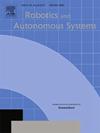Positioning of autonomous mobile robot using multi-lateration with pattern recognition and differential evolution
IF 5.2
2区 计算机科学
Q1 AUTOMATION & CONTROL SYSTEMS
引用次数: 0
Abstract
The extensive adoption of Autonomous Mobile Robots (AMR) in manufacturing, processing, and intelligent logistics has witnessed a remarkable increase, driven by the rapid growth of smart manufacturing and Industry 4.0. AMRs serve a dual role, facilitating both product handling and transportation. The precision of AMR positioning is of paramount importance. The prevalent approach to indoor positioning and navigation involves the use of cameras, optical Light Detection and Ranging (LiDAR) sensors. However, relying solely on LiDAR-based motion estimation for relative positioning can result in gradual displacement errors, impacting accuracy. This paper introduces a dual-positioning strategy to address this challenge, incorporating secondary localization methods to ensure precise spatial confirmation and task execution for a High Payload Autonomous Mobile Robot (HAMR). This proposed method integrates a RGB-D camera with the HAMR’s manipulator. It recognizes wall patterns (ArUco) and measures their distance from the HAMR, employing multi-lateration to calculate the HAMR’s position within the real-world coordinate system. This paper presents an indoor positioning method for HAMRs using ArUco code, enabling multi-lateration measurements within a 15 mm error. Differential Evolution (DE) is employed for motion analysis to solve inverse kinematics, enabling dynamic analysis of HAMRs with redundant degrees of freedom. This technique effectively compensates for positioning errors, significantly enhancing the AMR’s capabilities.
基于模式识别和差分进化的自主移动机器人定位
在智能制造和工业4.0快速发展的推动下,自主移动机器人(AMR)在制造、加工和智能物流领域的广泛应用取得了显著增长。amr起到双重作用,促进产品处理和运输。AMR定位的精度至关重要。室内定位和导航的普遍方法包括使用相机、光学光探测和测距(激光雷达)传感器。然而,仅仅依靠基于lidar的运动估计进行相对定位会导致逐渐的位移误差,影响精度。本文介绍了一种双定位策略来解决这一挑战,结合二次定位方法来确保高载荷自主移动机器人(HAMR)的精确空间确认和任务执行。该方法将RGB-D相机与HAMR机械臂集成在一起。它可以识别墙壁模式(ArUco),并测量它们与HAMR的距离,采用多层旋转来计算HAMR在现实世界坐标系中的位置。本文提出了一种基于ArUco码的hamr室内定位方法,实现了误差在15 mm以内的多方位测量。采用差分进化(DE)进行运动分析,求解运动学逆解,实现了具有冗余自由度的hamr的动力学分析。该技术有效地补偿了定位误差,显著提高了AMR的性能。
本文章由计算机程序翻译,如有差异,请以英文原文为准。
求助全文
约1分钟内获得全文
求助全文
来源期刊

Robotics and Autonomous Systems
工程技术-机器人学
CiteScore
9.00
自引率
7.00%
发文量
164
审稿时长
4.5 months
期刊介绍:
Robotics and Autonomous Systems will carry articles describing fundamental developments in the field of robotics, with special emphasis on autonomous systems. An important goal of this journal is to extend the state of the art in both symbolic and sensory based robot control and learning in the context of autonomous systems.
Robotics and Autonomous Systems will carry articles on the theoretical, computational and experimental aspects of autonomous systems, or modules of such systems.
 求助内容:
求助内容: 应助结果提醒方式:
应助结果提醒方式:


